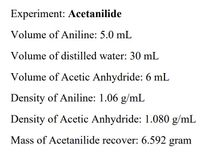
Chemistry
10th Edition
ISBN: 9781305957404
Author: Steven S. Zumdahl, Susan A. Zumdahl, Donald J. DeCoste
Publisher: Cengage Learning
expand_more
expand_more
format_list_bulleted
Question
please help me find the limiting regent given the data

Transcribed Image Text:### Experiment: Acetanilide Synthesis
#### Materials and Measurements:
1. **Volume of Aniline:** 5.0 mL
2. **Volume of Distilled Water:** 30 mL
3. **Volume of Acetic Anhydride:** 6 mL
4. **Density of Aniline:** 1.06 g/mL
5. **Density of Acetic Anhydride:** 1.080 g/mL
6. **Mass of Recovered Acetanilide:** 6.592 grams
This set of measurements and densities is crucial for the synthesis and recovery processes in the experiment of creating Acetanilide, an important compound in organic chemistry. This data would be used for calculations related to the reaction's yield, purity, and efficiency.
There are no graphs or diagrams provided in this image text. This information serves as a quantitative summary of the reagents used and the product obtained.
![### Determine the Limiting Reagent (Show Working)
**For example... For the reaction:**
\[ A + B \rightarrow C \]
Let's consider the amount of reactant A.
To determine the mole ratio of A, use the following calculation:
\[ \frac{20.00 \text{ g of A} \times 1 \text{ mol of A}}{1 \text{ MW of A}} = \text{mole ratio A} \]
Here, MW represents the Molecular Weight of A.
Thus, it can be represented as:
\[ 20.00 \text{ g of A} \times \left(\frac{1 \text{ mol of A}}{\text{MW of A}}\right) \times \left(\frac{1}{1 \text{ mol of A}}\right) = \text{mole ratio A} \]
By using this method, you can calculate the mole ratio of reactant A in the chemical reaction.](https://content.bartleby.com/qna-images/question/6746fa6f-1856-443b-addc-ecae5d9da9b9/60e6b0e1-599a-40e1-859d-4ee5fe803aec/mr4elfl_thumbnail.jpeg)
Transcribed Image Text:### Determine the Limiting Reagent (Show Working)
**For example... For the reaction:**
\[ A + B \rightarrow C \]
Let's consider the amount of reactant A.
To determine the mole ratio of A, use the following calculation:
\[ \frac{20.00 \text{ g of A} \times 1 \text{ mol of A}}{1 \text{ MW of A}} = \text{mole ratio A} \]
Here, MW represents the Molecular Weight of A.
Thus, it can be represented as:
\[ 20.00 \text{ g of A} \times \left(\frac{1 \text{ mol of A}}{\text{MW of A}}\right) \times \left(\frac{1}{1 \text{ mol of A}}\right) = \text{mole ratio A} \]
By using this method, you can calculate the mole ratio of reactant A in the chemical reaction.
Expert Solution
This question has been solved!
Explore an expertly crafted, step-by-step solution for a thorough understanding of key concepts.
This is a popular solution
Trending nowThis is a popular solution!
Step by stepSolved in 2 steps with 1 images

Knowledge Booster
Learn more about
Need a deep-dive on the concept behind this application? Look no further. Learn more about this topic, chemistry and related others by exploring similar questions and additional content below.Similar questions
- CO(g) effuses at a rate that is ______ times that of Kr(g) under the same conditions.arrow_forwardWhat would happen to the average kinetic energy of the molecules of a gas sample if the temperature of the sample decreased from 100°C to 50 C? OR would double OR would decrease would beceome half its value t would increasearrow_forwardImagine a system composed of two different types of molecules, one relatively light and one relatively heavy. At a particular temperature, which molecule has a higher average velocity? O Heavier molecule O Both the same O Lighter molecule Save Answerarrow_forward
arrow_back_ios
arrow_forward_ios
Recommended textbooks for you
 ChemistryChemistryISBN:9781305957404Author:Steven S. Zumdahl, Susan A. Zumdahl, Donald J. DeCostePublisher:Cengage Learning
ChemistryChemistryISBN:9781305957404Author:Steven S. Zumdahl, Susan A. Zumdahl, Donald J. DeCostePublisher:Cengage Learning ChemistryChemistryISBN:9781259911156Author:Raymond Chang Dr., Jason Overby ProfessorPublisher:McGraw-Hill Education
ChemistryChemistryISBN:9781259911156Author:Raymond Chang Dr., Jason Overby ProfessorPublisher:McGraw-Hill Education Principles of Instrumental AnalysisChemistryISBN:9781305577213Author:Douglas A. Skoog, F. James Holler, Stanley R. CrouchPublisher:Cengage Learning
Principles of Instrumental AnalysisChemistryISBN:9781305577213Author:Douglas A. Skoog, F. James Holler, Stanley R. CrouchPublisher:Cengage Learning Organic ChemistryChemistryISBN:9780078021558Author:Janice Gorzynski Smith Dr.Publisher:McGraw-Hill Education
Organic ChemistryChemistryISBN:9780078021558Author:Janice Gorzynski Smith Dr.Publisher:McGraw-Hill Education Chemistry: Principles and ReactionsChemistryISBN:9781305079373Author:William L. Masterton, Cecile N. HurleyPublisher:Cengage Learning
Chemistry: Principles and ReactionsChemistryISBN:9781305079373Author:William L. Masterton, Cecile N. HurleyPublisher:Cengage Learning Elementary Principles of Chemical Processes, Bind...ChemistryISBN:9781118431221Author:Richard M. Felder, Ronald W. Rousseau, Lisa G. BullardPublisher:WILEY
Elementary Principles of Chemical Processes, Bind...ChemistryISBN:9781118431221Author:Richard M. Felder, Ronald W. Rousseau, Lisa G. BullardPublisher:WILEY

Chemistry
Chemistry
ISBN:9781305957404
Author:Steven S. Zumdahl, Susan A. Zumdahl, Donald J. DeCoste
Publisher:Cengage Learning

Chemistry
Chemistry
ISBN:9781259911156
Author:Raymond Chang Dr., Jason Overby Professor
Publisher:McGraw-Hill Education

Principles of Instrumental Analysis
Chemistry
ISBN:9781305577213
Author:Douglas A. Skoog, F. James Holler, Stanley R. Crouch
Publisher:Cengage Learning

Organic Chemistry
Chemistry
ISBN:9780078021558
Author:Janice Gorzynski Smith Dr.
Publisher:McGraw-Hill Education

Chemistry: Principles and Reactions
Chemistry
ISBN:9781305079373
Author:William L. Masterton, Cecile N. Hurley
Publisher:Cengage Learning

Elementary Principles of Chemical Processes, Bind...
Chemistry
ISBN:9781118431221
Author:Richard M. Felder, Ronald W. Rousseau, Lisa G. Bullard
Publisher:WILEY